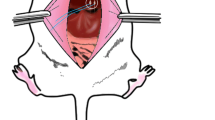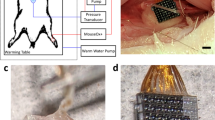Abstract
Background
Recently, the US FDA has approved “vagal blocking therapy or vBLoc® therapy” as a new treatment for obesity. The aim of the present study was to study the mechanism-of-action of “VBLOC” in rat models.
Methods
Rats were implanted with VBLOC, an intra-abdominal electrical device with leads placed around gastric vagal trunks through an abdominal incision and controlled by wireless device. Body weight, food intake, hunger/satiety, and metabolic parameters were monitored by a comprehensive laboratory animal monitoring system. Brain-gut responses were analyzed physiologically.
Results
VBLOC reduced body weight and food intake, which was associated with increased satiety but not with decreased hunger. Brain activities in response to VBLOC included increased gene expression of leptin and CCKb receptors, interleukin-1β, tumor necrosis factor, and transforming growth factor β1 in the brainstem; increased CCK, somatostatin, and tyrosine hydroxylase in the hippocampus; increased NPY, AgRP, and Foxa2 in the hypothalamus; and reduced CCKb receptor, melanocortin 4 receptor, and insulin receptor in the hypothalamus. Plasma concentrations of CCK, gastrin, glucagon, GLP-1, and PYY and gastric acid secretion were unchanged in response to VBLOC.
Conclusions
Based on the present study, we may suggest that VBLOC induces satiety through vagal signaling, leading to reduced food intake and loss of body weight.




Similar content being viewed by others
References
Buchwald H, Oien DM. Metabolic/bariatric surgery worldwide 2008. Obes Surg. 2009;19(12):1605–11.
Colquitt JL, Picot J, Loveman E, Clegg AJ 2009 Surgery for obesity. Cochrane Database Syst Rev.(2):CD003641.
Picot J, Jones J, Colquitt JL, Gospodarevskaya E, Loveman E, Baxter L, et al. The clinical effectiveness and cost-effectiveness of bariatric (weight loss) surgery for obesity: a systematic review and economic evaluation. Health Technol Assess. 2009;13(41):1–190 .215–357, iii-iv
Sam AH, Troke RC, Tan TM, Bewick GA. The role of the gut/brain axis in modulating food intake. Neuropharmacology. 2012;63(1):46–56.
Schwartz MW, Woods SC, Porte D, Seeley RJ, Baskin DG. Central nervous system control of food intake. Nature. 2000;404(6778):661–71.
Dockray GJ. Enteroendocrine cell signalling via the vagus nerve. Curr Opin Pharmacol. 2013;13(6):954–8.
Gautron L, Elmquist JK, Williams KW. Neural control of energy balance: translating circuits to therapies. Cell. 2015;161(1):133–45.
Ben-Menachem E, Hamberger A, Hedner T, Hammond EJ, Uthman BM, Slater J, et al. Effects of vagus nerve stimulation on amino acids and other metabolites in the CSF of patients with partial seizures. Epilepsy Res. 1995;20(3):221–7.
Grill HJ, Hayes MR. The nucleus tractus solitarius: a portal for visceral afferent signal processing, energy status assessment and integration of their combined effects on food intake. Int J Obes. 2009;33(1):10.
Imatake K, Matsui T, Moriyama M. The effect and mechanism of action of capsaicin on gastric acid output. J Gastroenterol. 2009;44(5):396–404.
Brunicardi FC, Shavelle D, Andersen D. Neural regulation of the endocrine pancreas. Int J Pancreatol. 1995;18(3):177–95.
Hampton T. Electric stimulation device approved to treat obesity. JAMA. 2015;313(8):785.
Ikramuddin S, Blackstone RP, Brancatisano A, Toouli J, Shah SN, Wolfe BM, et al. Effect of reversible intermittent intra-abdominal vagal nerve blockade on morbid obesity: the ReCharge randomized clinical trial. JAMA. 2014;312(9):915–22.
Furnes MW, Zhao CM, Chen D, et al. Obes Surg. 2009;19(10):1430–8.
Furnes MW, Tommeras K, Arum CJ, Zhao CM, Chen D. Gastric bypass surgery causes body weight loss without reducing food intake in rats. Obes Surg. 2008;18(4):415–22.
Debas HT, Carvajal SH. Vagal regulation of acid secretion and gastrin release. Yale J Biol Med. 1994;67(3–4):145–51.
Chen D, Zhao CM. Genetically engineered mice: a new paradigm to study gastric physiology. Curr Opin Gastroenterol. 2007;23(6):602–6.
Gil K, Bugajski A, Thor P. Electrical vagus nerve stimulation decreases food consumption and weight gain in rats fed a high-fat diet. J Physiol Pharmacol. 2011;62(6):637–46.
Ziomber A, Juszczak K, Kaszuba-Zwoinska J, Machowska A, Zaraska K, Gil K, et al. Magnetically induced vagus nerve stimulation and feeding behavior in rats. J Physiol Pharmacol. 2009;60(3):71–7.
Bugajski AJ, Gil K, Ziomber A, Zurowski D, Zaraska W, Thor PJ. Effect of long-term vagal stimulation on food intake and body weight during diet induced obesity in rats. J Physiol Pharmacol. 2007;1:5–12.
Krolczyk G, Laskiewicz J, Sobocki J, Matyja A, Kolasinska-Kloch W, Thor PJ. The effects of baclofen on the feeding behaviour and body weight of vagally stimulated rats. J Physiol Pharmacol. 2005;56(1):121–31.
Laskiewicz J, Krolczyk G, Zurowski G, Sobocki J, Matyja A, Thor PJ. Effects of vagal neuromodulation and vagotomy on control of food intake and body weight in rats. J Physiol Pharmacol. 2003;54(4):603–10.
Sobocki J, Fourtanier G, Estany J, Otal P. Does vagal nerve stimulation affect body composition and metabolism? Experimental study of a new potential technique in bariatric surgery. Surgery. 2006;139(2):209–16.
Val-Laillet D, Biraben A, Randuineau G, Malbert CH. Chronic vagus nerve stimulation decreased weight gain, food consumption and sweet craving in adult obese minipigs. Appetite. 2010;55(2):245–52.
Silva JP, von Meyenn F, Howell J, Thorens B, Wolfrum C, Stoffel M. Regulation of adaptive behaviour during fasting by hypothalamic Foxa2. Nature. 2009;462(7273):646–50.
Clerc P, Coll Constans MG, Lulka H, Broussaud S, Guigne C, Leung-Theung-Long S, et al. Involvement of cholecystokinin 2 receptor in food intake regulation: hyperphagia and increased fat deposition in cholecystokinin 2 receptor-deficient mice. Endocrinology. 2007;148(3):1039–49.
Huszar D, Lynch CA, Fairchild-Huntress V, Dunmore JH, Fang Q, Berkemeier LR, et al. Targeted disruption of the melanocortin-4 receptor results in obesity in mice. Cell. 1997;88(1):131–41.
Revesz D, Tjernstrom M, Ben-Menachem E, Thorlin T. Effects of vagus nerve stimulation on rat hippocampal progenitor proliferation. Exp Neurol. 2008;214(2):259–65.
Guan Y, Tang M, Jiang Z, Peeters TL. Excitatory effects of motilin in the hippocampus on gastric motility in rats. Brain Res. 2003;984(1–2):33–41.
Diano S, Farr SA, Benoit SC, McNay EC, da Silva I, Horvath B, et al. Ghrelin controls hippocampal spine synapse density and memory performance. Nat Neurosci. 2006;9(3):381–8.
Davidson TL, Kanoski SE, Walls EK, Jarrard LE. Memory inhibition and energy regulation. Physiol Behav. 2005;86(5):731–46.
Forloni G, Fisone G, Guaitani A, Ladinsky H, Consolo S. Role of the hippocampus in the sex-dependent regulation of eating behavior: studies with kainic acid. Physiol Behav. 1986;38(3):321–6.
Tracy AL, Jarrard LE, Davidson TL, et al. Behav Brain Res. 2001;127(1–2):13–23.
Author information
Authors and Affiliations
Corresponding author
Ethics declarations
Conflict of Interest
Authors 1–7, 9–15 have nothing to disclose in connection with this study.
Author 8 has received grants from Novo Nordisk, Zealand Pharmaceuticals, AstraZeneca, Sanofi, MSD, GSK, Intarcia, Norvartis, and Hamni, outside the submitted work.
Ethical Approval
All applicable institutional and/or national guidelines for the care and use of animals were followed.
Informed Consent
Does not apply.
Additional information
An erratum to this article is available at http://dx.doi.org/10.1007/s11695-016-2370-2.
Electronic supplementary material
ESM 1
(DOCX 28 kb)
Rights and permissions
About this article
Cite this article
Johannessen, H., Revesz, D., Kodama, Y. et al. Vagal Blocking for Obesity Control: a Possible Mechanism-Of-Action. OBES SURG 27, 177–185 (2017). https://doi.org/10.1007/s11695-016-2278-x
Published:
Issue Date:
DOI: https://doi.org/10.1007/s11695-016-2278-x




